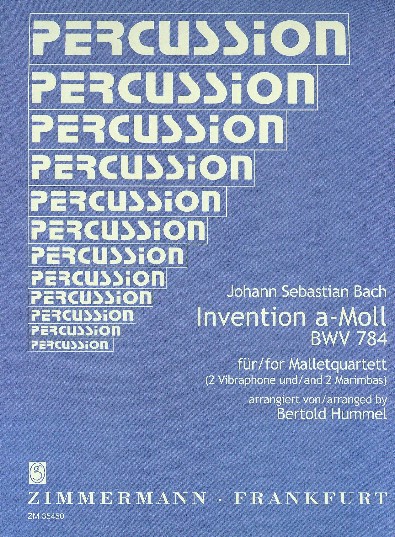J.S. Bach:
Invention a-minor BWV 784 for 4 Marimbaphones (or 2 Vibraphones and 2 Marimbaphones)
(1996)

Publisher:
Zimmermann Frankfurt ZM 35450 / ISMN M-010-35450-7
Preface (Zimmermann Frankfurt ZM 35450)
"Invention
in A minor for 4 mallet Instruments" by Bertold Hummel was the result of
an idea for an attempt at musical experimentation and refers to the well-known
"Invention in A minor" by Johann Sebastian Bach. Originally, J. S. Bach
wrote down these musical ideas in 1723 as didactic pieces and as an instruction
in how to "achieve a cantabile style of playing". This collection of
pieces has served as ideal material for the musical education of young artists
for nearly 300 years now.
In
B. Hummel's arrangement, the two-part piano piece is presented as a patchwork
divided among four parts, thus giving four percussionists the opportunity to practise
cantabile playing on mallet Instruments. In his draft of the score, B. Hummel
prescribes the use of 4 marimbas (with the possible alternative of 2 vibraphones
and 2 marimbas). He explains this as follows: "The parts contained in brackets
are original and should be played louder than the "counterpoints" l
have invented throughout". In his Inventions, J.S.Bach is known to have done
without dynamic instructions, and, therefore, in the first 4 bars of the arrangement,
the musical Interpretation is suggested by the dynamic marks added for guidance.
As in the original, the musicians are given free rein to apply their musical creativity
as the composition progresses.
A carefully considered stroke sequence has been
added below each of the individual parts, which lends itself particularly well
in terms of improved practicability. These stroke sequences, which are always
followed by a change of hands, are placed as sparingly as possible, but wherever
they are helpful and necessary. The suggestions of alternatives in Instrumentation
provide further recommendation of the piece as teaching material.
A performance
of this score true to the original requires:
Soprano: c-marimba (4-octave)
Alto:
c-marimba (4-octave)
Tenor: A-marimba (4 1 /3-octave)
Bass: C-marimba (5-octave)
As
an alternative, Hummel suggests using two vibraphones (1: soprano, 2: alto) in
place of the 2 marimbas in the upper part.
In order to ensure that the parts
are conducted homogeneously when this Version is performed, particular attention
should be given to the differences in tone duration between the marimba and the
vibraphone.
The following is another alternative suggested for performance
practice in music schools:
Soprano: Xylophone
Alto: marimba (together with
bass)
Tenor: vibraphone
Bass: E, For A-marimba
By shifting only a few
notes, it is possible in this case to perform the score on only three mallet Instruments.
Thomas
Keemss
Press
Percussive Notes, October 2007
This
keyboard percussion quartet is scored for two vibraphones and two marimbas (one
low-A and one four-octave). The editor also gives the option of using four marimbas.
The parts are equally distributed in difficulty among the four players. Brackets
are provided to identify the inventions, and should be performed louder than the
counterpoint material.
Each part can be performed with two mallets, although
if using vibra-phones, four mallets might facilitate dampening. There are a few
sticking and hand suggestions, but these are only suggestions. This is a terrific
setting of the famous invention and a challenge for all four players.
-George
Frock